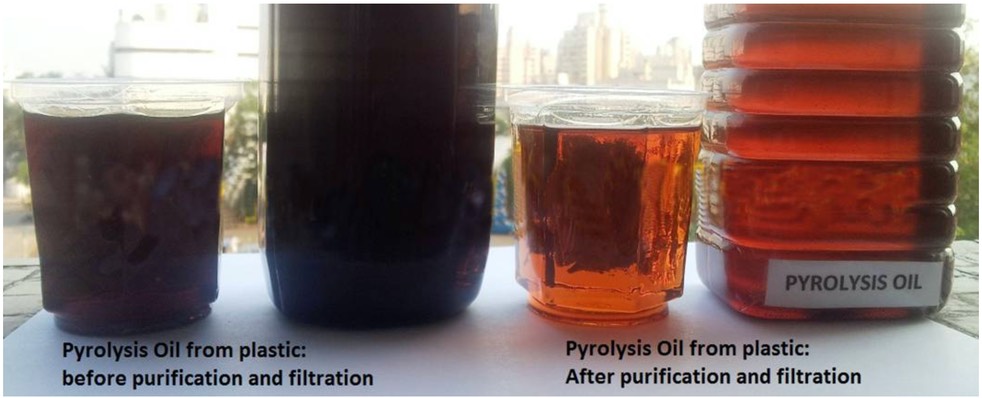WASTE PLASTICS TO FUEL OIL
The system uses liquefaction, pyrolysis and distillation of plastics. The system can handle almost all the End of Life Plastic that is currently being sent to landfills. A major advantage of the process is its high efficiency. Each plant can produce up to 19k litres of fuel from 20 tonnes of End of Life Plastic.
Current Situation of Recycling of Plastics
Various methodologies have been tried and tested to process waste or end of life plastics for many years, with recycling becoming the most common method reflecting the needs of today. Plastics that cannot be processed are handled by waste management companies mainly through land-filling or incineration.
The building or expanding of incinerators has become difficult due to opposition from governments and community groups with environmental concerns, most notably the levels of emissions.
Liquefaction of plastic is a superior method of reusing this resource. These distillate products are excellent fuels and make the Technology one of the best, economically feasible and environmentally sensitive recycling systems in the world today.
The synthetic fuels produced, given their low sulphur and high cetane qualities, will most likely be utilised by the recycling organisations on-site for use in the vehicle fleet as SITA plan to do or heavy equipment and generators.
Pyrolysis is a process of thermal degradation of a material in the absence of oxygen. Plastic is continuously treated in a cylindrical chamber and the pyrolytic gases condensed in a specially-designed condenser system to yield a hydrocarbon distillate comprising straight and branched chain aliphatics, cyclic aliphatics and aromatic hydrocarbons. The resulting mixture is essentially equivalent to petroleum distillate. The plastic is pyrolised at 370ºC-420ºC and the pyrolysis gases are condensed and liquid separated using fractional distillation to produce the liquid fuel products.
The essential steps in the pyrolysis of plastics involves:
- evenly heating the plastic to a narrow temperature range without excessive temperature variations
- purging oxygen from pyrolysis chamber,
- managing the carbonaceous char by-product before it acts as a thermal insulator and lowers the heat transfer to the plastic
- careful condensation and fractionation of the pyrolysis vapours to produce distillate of good quality and consistency
Structure of the System
The system consists of stock in-feed system, pyrolysis chambers, contactors, distillation, oil recovery line and syn-gas..
End of Life Plastics are loaded via a hot-melt infeed system directly into main pyrolysis chamber.
Agitation commences to even the temperature and homogenise the feedstocks. Pyrolysis then commences and the plastic becomes a vapour. Non-plastic materials fall to the bottom of the chamber.
The vapour is converted into the various fractions in the distillation column, the distillates then pass into the recovery tanks.
The System diverts the Syn Gas through a Scrubber and then back into the furnaces to heat the pyrolysis chambers.
The cleaned distillates are then pumped to the storage tanks.
The heart of the pyrolysis system is the prime chamber, which performs the essential functions of homogenisation and controlled decomposition in a single process. The process requires minimal maintenance and produces a consistent quality distillate from End of Life Plastic..
The key to an efficient pyrolysis process is to ensure the plastic is heated uniformly and rapidly. If temperature gradients develop in the molten plastic mass then different degrees of cracking will occur and products with a wide distribution of chain lengths will be formed.
Technology - Process Flow Diagram
Turn waste Plastic in to Energy
Oil Calorific Value =10293Kcal / Kg---this OIL is also used for domestic Heating Oil
Oil Extraction per 1kg of plastic ? 0.7 to 0.9 Ltrs depending on raw material
Plastic = KW Energy-------this is a close guideline calculation of any Steam Generators! This guideline depends on the plastic quality!
1MW steam generators usage of “Plastic” Heating Oil 416- Ltrs/Hrs
- Daily amount of Plastic = 12 Tons
2MW steam generators usage of “Plastic” Heating Oil 830 Ltrs/Hrs
- Daily amount of Plastic = 24 Tons
3MW steam generators usage of “Plastic” Heating 1250 Ltrs/Hrs
- Daily amount of Plastic = 36 Tons
5MW steam generators usage of Heating Oil 690 Ltrs/Hrs
- Daily amount of Plastic = 60 Tons
Alternative use of the Plastic Oil ?
You can mix the Plastic Oil 50/50 with diesel fuel and use it in diesel engine i.e.; diesel generators / Lorries / Cars etc ! Please check your governmental legislation on fuel Tax.
Questions and answers below :
Is there any residue from the plastic left over like "Tar" Bitumen and if so what is the percentage? And what do you recommend we do with it.
We get 2% of bitumen or asphaltine which is fed back into the reactor again for breaking it into Pyrolysis oil
How do you start the Heat in the reactor when starting the system ?
By diesel firing (around 20 litres diesel for 2 hours) and then pyrolysis gas is used
Can you also use old CD ?
Yes we can use old CDs but as CDs are made up of polycarbonate there will be 30% increase in gas. We will get 40% gas, 40 To 50% oil and rest carbon
Can you tell us what plastic you can not use? - and how can we separate those Plastic from the rest?
It has to be AUTOMATIC ! Recommendation for Pyrolysis Plant Raw Material file has been attached (if applied for) for your kind reference.
This is an extra , if our client also want to burn Tyres how do you remove the METAL Wires ? And is there also a residue left over?
Shredding machines can be used to separate the metal wires from tyres.

